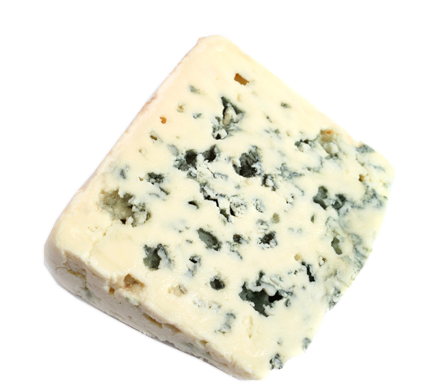Our
products

TS 10.51.40-086-00437062
Ingredients: cow milk, starter culters of mesophilic and thermopihlic lactic-acid bacteria, mold Penicillium roqueforti, milk-clotting enzyme of animal origin, salt.
Nutritional value (per 100 g): fat 25 g, protein 20,3 g.
Energy value– 306 kcal/1270 kJ.
Fat in dry matter — 50%.
Shelf life – 45 days at a temperature of -4–0 °С and relative humidity 80–85 %.
Cheese “Russian Roquefort” is an alternative of French Roquefort cheese streaked with noble blue mold.
We produce this cheese using cow milk and mold traditional for Roquefort – Penicillium roqueforti. “Russian Roquefort” ripens in special ripening room where optimal for the mold temperature and moisture keep.
“Russian Roquefort” has fine light oily consistency and sharp, pungent and salty taste and aroma.
Like a typical blue cheese “Russian Roquefort”, contains essential vitamins and minerals, including vitamins A, D, B 12, sodium, potassium, zinc, magnesium etc.
Also, dairy products, including “Russian Roquefort”, are an excellent source of calcium which is essential in the strengthening of teeth and bones.
Like all cheeses and dairy products, “Russian Roquefort” is an excellent source of protein and amino acids, which are essential in the development of strong cells, muscles, and organs.
Significantly, nutrients of “Russian Roquefort” are highly digestible.
Addition of blue cheese like “Russian Roquefort” in your diet may help in lowering the risk of cardiovascular diseases. Studies have shown that people who consume blue cheese regularly have a lower risk of contracting cardiovascular diseases than their counterparts who do not consume it. Blue cheese also helps in lowering cholesterol levels, and prevents artery inflammation and blood clotting in veins or arteries.
Blue cheese possesses anti-inflammatory properties that help in reducing joint inflammation and relieve arthritis pain. Addition of blue cheese in your diet plan lowers the risk of arthritis and also helps in combating it.
Nutrients present in blue cheese help in enhancing memory and fight memory problems. Consumption of blue cheese enhances brain cell functioning.
There are many uses for blue cheeses like “Russian Roquefort” in the kitchen and on menus, from appetizers, salads, and snacks, to cooked dishes and desserts.
Generally, the strong flavor of blue cheeses pairs well with strong-flavored foods and beverages.
There are some ways of using it.
Serve it as it is. One of the best ways actually is serving it with salty crackers, rye bread and butter, fresh figs, some roasted almonds, some jam or marmalade. Great marmalades to go with the cheese are rosehip, fig, pear, and quince. Also, sweet vinegar or pickled fruits work good with blue cheese. Don’t forget the wine. “Russian Roquefort” goes well with full body red wines or sweet white wine like Marsala and Muscat.
For all sorts of dips, vegetables and a blue cheese dip is a classic combination.
For sandwiches, burgers and salads, it pairs great with all salads, try adding bacon, some endives, romaine lettuce and leeks.
Try adding some blue cheese into gravy, especially if you’re serving game like venison or anything similar but it is also great with beef.
“Roquefort” story
Roquefort is an ancient cheese which dates back about 2,000 years and it well deserves its reputation as one of France's national treasures. We know that Roquefort dates back at least to 79 C.E. because Pliny the Elder wrote about its rich aroma.
But legend dates the cheese even earlier, with a story about a poor shepherd who saw a beautiful girl in the distant hills of South Central France. Determined to follow her, he left his simple lunch of rye bread and cheese behind in one of the crevasses found throughout the limestone cliffs in the region. Some days later he returned alone, disappointed and starving – only to find that his bread had turned moldy and the mold spores had migrated onto and into his hunk of cheese. His paltry meal didn't look very appetizing, but he ate it anyway and found to his delight, that the cheese was truly delicious. "Merveilleux!" he cried – and rich, buttery, tangy Roquefort cheese was born.